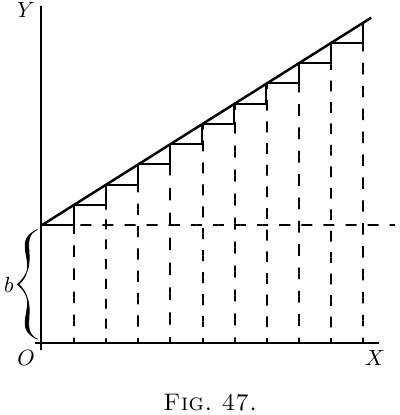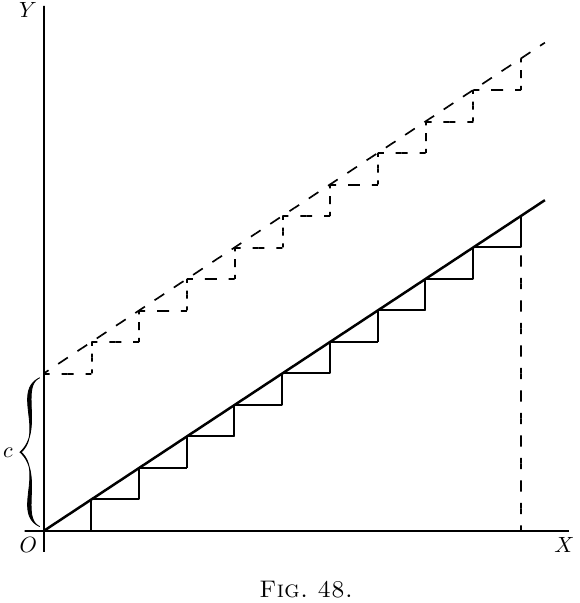
Slopes of Curves, and the Curves themselves.
Let us make a little preliminary enquiry about the slopes of curves. For we have seen that differentiating a curve means finding an expression for its slope (or for its slopes at different points). Can we perform the reverse process of reconstructing the whole curve if the slope (or slopes) are prescribed for us?
Go back to case (2) on here. Here we have the simplest of curves, a sloping line with the equation \[ y = ax+b. \]
We know that here $b$ represents the initial height
of $y$ when $x= 0$, and that $a$, which is the same as $\dfrac{dy}{dx}$,
is the “slope” of the line. The line has a constant
slope. All along it the elementary triangles
have the same proportion between height and base.
Suppose we were to take the $dx$'s, and $dy$'s of finite
magnitude, so that $10$ $dx$'s made up one inch, then
there would be ten little triangles like
Now, suppose that we were ordered to reconstruct
the “curve,” starting merely from the information
that $\dfrac{dy}{dx} = a$. What could we do? Still taking the
little $d$'s as of finite size, we could draw $10$ of them,
all with the same slope, and then put them together,
end to end, like this:
And, as the slope is the same for all, they would join
to make, as in Figure 48, a sloping line sloping with the
correct slope $\dfrac{dy}{dx} = a$. And whether we take the $dy$'s
and $dx$'s as finite or infinitely small, as they are all
alike, clearly $\dfrac{y}{x} = a$, if we reckon $y$ as the total of
all the $dy$'s, and $x$ as the total of all the $dx$'s. But
whereabouts are we to put this sloping line? Are
we to start at the origin $O$, or higher up? As the
only information we have is as to the slope, we are
without any instructions as to the particular height
above $O$; in fact the initial height is undetermined.
The slope will be the same, whatever the initial height.
Let us therefore make a shot at what may be wanted,
and start the sloping line at a height $C$ above $O$.
That is, we have the equation
\[
y = ax + C.
\]
It becomes evident now that in this case the added
constant means the particular value that $y$ has when
$x = 0$.
Now let us take a harder case, that of a line, the
slope of which is not constant, but turns up more and
more. Let us assume that the upward slope gets
greater and greater in proportion as $x$ grows. In
symbols this is:
\[
\frac{dy}{dx} = ax.
\]
Or, to give a concrete case, take $a = \frac{1}{5}$, so that
\[
\frac{dy}{dx} = \tfrac{1}{5} x.
\]
Then we had best begin by calculating a few of
the values of the slope at different values of $x$, and
also draw little diagrams of them.
When













